双生素数无上界
- 格式:pdf
- 大小:180.42 KB
- 文档页数:3
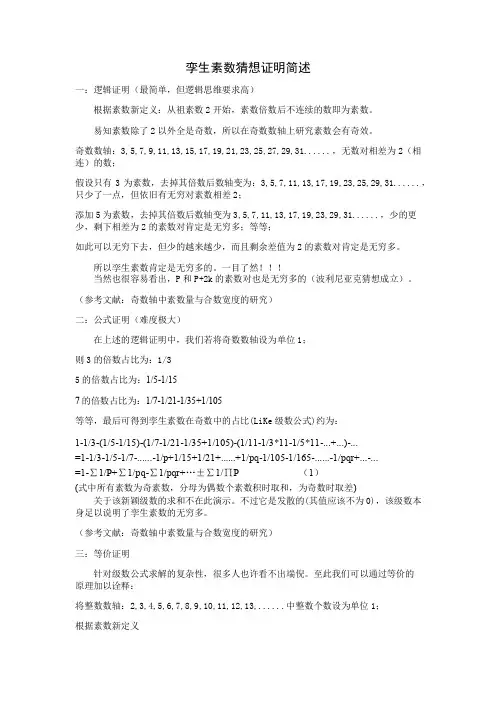
孪生素数猜想证明简述一:逻辑证明(最简单,但逻辑思维要求高)根据素数新定义:从祖素数2开始,素数倍数后不连续的数即为素数。
易知素数除了2以外全是奇数,所以在奇数数轴上研究素数会有奇效。
奇数数轴:3,5,7,9,11,13,15,17,19,21,23,25,27,29,31......,无数对相差为2(相连)的数;假设只有3为素数,去掉其倍数后数轴变为:3,5,7,11,13,17,19,23,25,29,31......,只少了一点,但依旧有无穷对素数相差2;添加5为素数,去掉其倍数后数轴变为3,5,7,11,13,17,19,23,29,31......,少的更少,剩下相差为2的素数对肯定是无穷多;等等;如此可以无穷下去,但少的越来越少,而且剩余差值为2的素数对肯定是无穷多。
所以孪生素数肯定是无穷多的。
一目了然!!!当然也很容易看出,P和P+2k的素数对也是无穷多的(波利尼亚克猜想成立)。
(参考文献:奇数轴中素数量与合数宽度的研究)二:公式证明(难度极大)在上述的逻辑证明中,我们若将奇数数轴设为单位1;则3的倍数占比为:1/35的倍数占比为:1/5-1/157的倍数占比为:1/7-1/21-1/35+1/105等等,最后可得到孪生素数在奇数中的占比(LiKe级数公式)约为:1-1/3-(1/5-1/15)-(1/7-1/21-1/35+1/105)-(1/11-1/3*11-1/5*11-...+...)-...=1-1/3-1/5-1/7-......-1/p+1/15+1/21+......+1/pq-1/105-1/165-......-1/pqr+...-...=1-∑1/P+∑1/pq-∑1/pqr+…±∑1/∏P (1)(式中所有素数为奇素数,分母为偶数个素数积时取和,为奇数时取差)关于该新颖级数的求和不在此演示。
不过它是发散的(其值应该不为0),该级数本身足以说明了孪生素数的无穷多。

中国剩余定理·双生素数猜想·哈代-李特伍德猜想(B)Chinese remainder theorem,twin primes conjecture andHardy-Littlewood conjecture(B)童 信 平**********************摘要 双生素数(p,p+k)中,①若p 、k 对模p 的余数相加等于p i i ,则p 不是双生素数(p,p+k)的答案;若i=1~r 时,p 、k 对模p 的余数相加皆不等于p i i ,则p 是双生素数(p,p+k)的答案。
②对于模p ~p 1r ,根据中国剩余定理,可以通过建立不同的同余式组,计算出双生素数(p,p+k)中的p 。
③(p+k)中必有素数,双生素数猜想成立。
同时指出,双生素数(p,p+k)有无限多对。
④讨论了哈代-李特伍德猜想(B )中的细节(未揭示的参变量)问题。
关键词 同余 中国剩余定理 双生素数猜想 哈代-李特伍德猜想(B)存在无限多对双生素数。
――这就是常说的双生素数猜想。
哈代-李特伍德猜想(B)则是关于双生素数(p,p+k)数量的猜想。
对于偶数k=2n 、不大于偶数(N -k)的素数p 和p ,我们有(p ,p +k)和(p,p+k)组成的正整数对, i i i ,(p (p )+k(p ①若p 、k 对模p 的余数相加等于p )=p i i i i i 。
)此时,p 不是双生素数(p,p+k)的答案;若i=1~r 时,p 、k 对模p ,(p (p )+k(p 的余数相加皆不等于p )≠p i i i i i 。
)此时,p 是双生素数(p,p+k)的答案。
②对于模p ~p 1r ,根据中国剩余定理,可以通过建立不同的同余式组,计算出双生素数(p,p+k)中的p 。
③(p+k)中必有素数,双生素数猜想成立。
同时指出,双生素数(p,p+k)有无限多对。
④讨论了哈代-李特伍德猜想(B )中的细节(未揭示的参变量)问题。
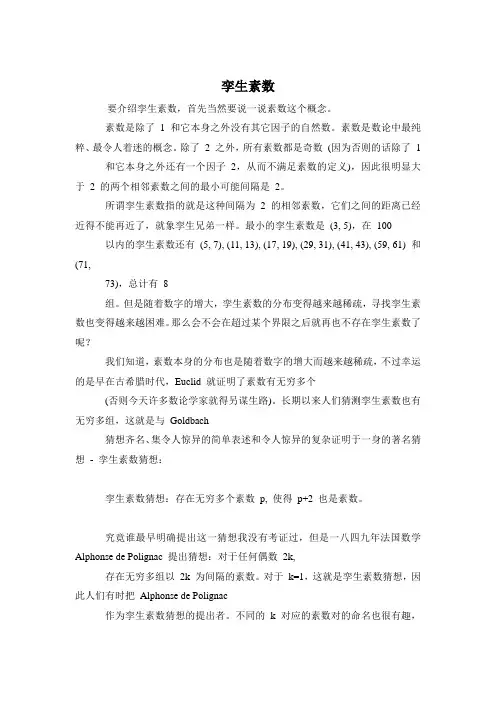
孪生素数要介绍孪生素数,首先当然要说一说素数这个概念。
素数是除了1 和它本身之外没有其它因子的自然数。
素数是数论中最纯粹、最令人着迷的概念。
除了 2 之外,所有素数都是奇数(因为否则的话除了 1 和它本身之外还有一个因子2,从而不满足素数的定义),因此很明显大于2 的两个相邻素数之间的最小可能间隔是2。
所谓孪生素数指的就是这种间隔为2 的相邻素数,它们之间的距离已经近得不能再近了,就象孪生兄弟一样。
最小的孪生素数是(3, 5),在100 以内的孪生素数还有(5, 7), (11, 13), (17, 19), (29, 31), (41, 43), (59, 61) 和(71,73),总计有8组。
但是随着数字的增大,孪生素数的分布变得越来越稀疏,寻找孪生素数也变得越来越困难。
那么会不会在超过某个界限之后就再也不存在孪生素数了呢?我们知道,素数本身的分布也是随着数字的增大而越来越稀疏,不过幸运的是早在古希腊时代,Euclid 就证明了素数有无穷多个(否则今天许多数论学家就得另谋生路)。
长期以来人们猜测孪生素数也有无穷多组,这就是与Goldbach猜想齐名、集令人惊异的简单表述和令人惊异的复杂证明于一身的著名猜想- 孪生素数猜想:孪生素数猜想:存在无穷多个素数p, 使得p+2 也是素数。
究竟谁最早明确提出这一猜想我没有考证过,但是一八四九年法国数学Alphonse de Polignac 提出猜想:对于任何偶数2k,存在无穷多组以2k 为间隔的素数。
对于k=1,这就是孪生素数猜想,因此人们有时把Alphonse de Polignac作为孪生素数猜想的提出者。
不同的k 对应的素数对的命名也很有趣,k=1 我们已经知道叫做孪生素数,k=2 (即间隔为4) 的素数对被称为cousin prime (比twin 远一点),而k=3 (即间隔为6) 的素数对竟然被称为sexy prime (这回该相信“书中自有颜如玉”了)!不过别想歪了,之所以称为sexy prime 其实是因为sex 正好是拉丁文中的6。
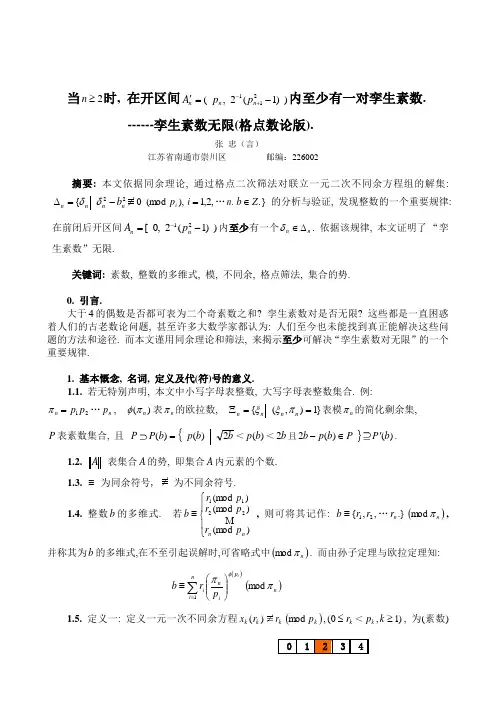
当2≥n 时, 在开区间))1(2,(211-='+-n n np p A 内至少有一对孪生素数. ------孪生素数无限(格点数论版).张 忠(言)江苏省南通市崇川区 邮编:226002摘要: 本文依据同余理论, 通过格点二次筛法对联立一元二次不同余方程组的解集:22{nn n n b -=∆δδ),(mod 0i p ,2,1=i ….n .}Z b ∈ 的分析与验证, 发现整数的一个重要规律:在前闭后开区间))1(2,0[21-=-n n p A 内至少有一个n n ∆∈δ. 依据该规律, 本文证明了“孪生素数”无限.关键词: 素数, 整数的多维式, 模, 不同余, 格点筛法, 集合的势.0. 引言.大于4的偶数是否都可表为二个奇素数之和? 孪生素数对是否无限? 这些都是一直困惑着人们的古老数论问题, 甚至许多大数学家都认为: 人们至今也未能找到真正能解决这些问题的方法和途径. 而本文谨用同余理论和筛法, 来揭示至少可解决“孪生素数对无限”的一个重要规律.1. 基本慨念, 名词, 定义及代(符)号的意义.1.1. 若无特别声明, 本文中小写字母表整数, 大写字母表整数集合. 例:n π=21p p …n p , )(n πφ表n π的欧拉数, }1),({==Ξn n n n πξξ表模n π的简化剩余集,P 表素数集合, 且P{b b p b P 2)()(=<)(b p <b 2且}Pb p b ∈-)(2)(b P '.1.2. A 表集合A 的势, 即集合A 内元素的个数. 1.3. ≡ 为同余符号, 为不同余符号.1.4. 整数b 的多维式. 若⎪⎩⎪⎨⎧≡)(mod )(mod )(mod 2211n n p r p r p r b , 则可将其记作: ,,{21r r b ≡….}n r ()n πmod ,并称其为b 的多维式,在不至引起误解时,可省略式中()n πmod . 而由孙子定理与欧拉定理知:()i p inni i pr b φπ⎪⎪⎭⎫⎝⎛≡∑=1()n πmod1.5. 定义一: 定义一元一次不同余方程)(k k rx k r ()k p mod ,k r ≤0(<)1,≥k p k , 为(素数)模k p 之k r 的(一次)筛, 简记为)(k k r s , 例: )2(33s 为: 而该不同余方程的解称)(k k r x 称为)(k k r s 的缩剩余, )(k k r X 为)(k k r s 的缩剩余集. 作为特例, 当)(k k rx 0=k r ()k p mod 时, )0(k x 称为模k p 的简化剩余,)0(k X 为模k p 的简化剩余集.1.6. 定义二. 若: n n b π≤≤1, ,,{21r r b n ≡….}n r , 则定义联立(一次)不同余方程组:xi n r b ≡()i p mod ,i r ≤0(<)i p ,,2,1=i ….n 为(合数)模n π之n b 筛, 并简记为: )(n n b S 或,,({21r r S n ….})n r . 该联立方程的解x 称为(合数)模n π之n b 筛的(一次)缩剩余. 作为特例: 当0=n b 时, 该联立方程的解x 即模n π的简化剩余}1),({==Ξ∈n n n n n πξξξ. 图一: )0(.})0,0,0({)0(132133s S S ≡≡)0(2s )0(3s 的格点筛紧 接 下图紧 接 上 图由图一: )0(3S 可得模305323=⨯⨯=π的最小正简化剩余系: .}29,23,19,17,13,11,7,1{min 3=Ξ⊕. 1.7. 定义三: 若k r b ≡()k p mod ,)(201k k p r φ-≤≤,1<Nk ∈,则定义不同余方程:kx k r b ±≡±()k p mod ,为(素)模k p 之)(b ±(或k r ±)的二次筛, 并简记为)(k k r s ±; k x 为)(k k r s ±的二次缩剩余, 为区别k x 与模k p 之其它二次筛的缩剩余, 模k p 之)(k r ±筛的缩剩余记为)(b x k ±或)(k k r x ±.因当2≥k 且kr b ≡0()k p mod 时: b 与b -分别为模k p 的两个不同剩余类, 但模k p 之b的二次筛与模k p 之b -的二次筛相同, 故模k p 之b 的二次筛与模k p 之b -的二次筛为模k p 之异名同类筛, 故知模k p 之二次异名同类筛的二次缩剩余也相同. 模k p 之)(k r ±筛系内有且仅有)1(21+-k p 类筛: )0(k s ,)1(±k s ,)2(±k s ,…())(21k k p s φ-±.例一: 图二为求)2(4±s 的最小非负二次缩剩余系.}6,4,3,1,0{)2(4=±X 的格点图解法:图二. )2(4±s :(注: 上图列中含红色格点的整数表示被)2(4±s 筛除.)又: .}3,1,0{)2(4±±≡±X ()7mod . 称为筛)2(4±s 的最小绝对值缩剩余系.1.8. 定义四. 若: ,,{21r r b n ≡….}n r , )(201i i p r φ-≤≤, ,2,1=i ….n 则定义不同余方程组: )(b n ±δi r b ±≡±()i p mod ,,2,1=i ….n 为(合数)模n π之)(n b ±的二次筛)(n n b S ±: ,,{()(21r r S b S n n n ±≡±…)(})11r s r n ±≡)(22r s±…)(n n r s ± ()n πmod .)(b n ±δ的任一确定值称为不同余方程组的(关于模n π的)一个解类(或特解). 从二次不同余方程组的各类解中任取一个)(b n ±δ值组成的集合)(n n b ±∆为该二次不同余方程组 (关于模n π)的解系, 即,,{(21r r S n ±…})n r 的(关于模n π的)二次缩剩余系. 故知:,,{()(21r r b n n n ±∆≡±∆…)(})11r X r n ±≡)(22r X±…)(n n r X ± ()n πmod例二. 当3=n , .}1,1,1{13213≡==b b n 时: 305323213=⨯⨯===p p p n ππ, 模3π之)(3b ±的最小非负二次缩剩余系.})1,1,1{()(321333±∆=±∆b 可由图三:获知:.}18,12,0{)1(3≡±∆()30mod ; 也可将其表为模3π之)(3b ±的最小绝对值二次缩剩余系: .}12,0{)1(3±≡±∆()30mod .图三. =±.})1,1,1{(3213S )1(1±s )1(2±s )1(3±s紧 接 下图紧 上 接 图又因:.}1,1,1{1321≡,.}1,1,1{11321-≡,.}1,1,1{19321-≡,.}1,1,1{29321--≡, 所以: )1(3±S ,)11(3±S ,)19(3±S ,)29(3±S 是模3π的二次异名同类筛, 故:)29()19()11()1(3333±=±=±=±S S S S , 且:)1(3±∆=)11(3±∆=)19(3±∆=)29(3±∆=.}18,12,0{. 1.9. 虚筛与实筛. 若: i p <j p <…k p , 而a 同时被)(i i r s ,)(j j r s ,…)(k k r s 筛除, 则称a 被且仅被)(i i r s 实筛, 而分别被)(j j r s ,…)(k k r s 等虚筛; 若集合A 中有一元素被)(k k r s 实筛, 则称集合A 被)(k k r s 实筛, 若集合A 中无一元素被)(k k r s 实筛, 则称集合A 被)(k k r s 虚筛.2. 引理及定理.引理一. 受)(*±n n b S 最大二次筛除的区间n A , 必分别受 )(*±i i b s (,2,1=i ….n ) 的实筛. 证: 设受)(*±n n b S 最大二次筛除的区间n A 内)(*±n n b δ的个数最少, 有且仅有1≥e 个, 且其中一个a b n n =±*)(δ. 现反设n A 受)(k k r s ±(.1n k ≤≤)虚筛, 则由k r a ≡()k p mod 知, 必存在整数n b ': *≡'n n b b ()k n p πm o d 且 k n r b ≡'()k p mod , 故知: )()()(k k np k n k p kn n p r p b b φπφπ+≡'*()n πmod则受模k n p π之n b '±二次筛的区间n A 内有且仅有1≥e 个)(*±n n b δ,当n A 再受模k p 之nb '±的二次筛时, a b n n =±*)(δ必被)(k k r s ±实筛, 即受)(nn b S '±筛除的区间n A 必受)(k k r s ±实筛, n A 内最多仅有01≥-e 个)(nn b '±δ, 该结论与原设矛盾, 故知引理一成立. 定理一. 若: 2≥n , n n b π≤≤1, 前闭后开区间))1(2,0[21-=-n n p A , 模n π之)(n b ±筛的二次缩剩余系为:)(n n b ±∆, )()(n n n n b b ±∆=±∆⊕n A , 则: 受模n π之)(n b ±最大二次筛的n A 内至少有一个)(n n b ±δ, 即: 1)(min≥±∆⊕n n b . (证明暂略! 详情请见文后说明①.)下面仅给出定理一的验证方法及当6,5,4,3,2=n 时的验证结果,以供参考.(1) 当2=n 时: 32==p p n , )4,0[))1(2,0[2212=-==-p A A n , 6212===p p n ππ,)(22b ±∆是模2π之2b ±的二次缩剩余集, )(.}),{(22212b r r ±∆=±±∆⊕2A ,模2π的二次筛系.}),{(212r r S ±内有且仅有412=+p 类两两不同的筛:.})0,0{(212±S ,.})1,0{(212±S ,.})0,1{(212±S ,.})1,1{(212±S ,则由格点二次筛法可求.}),{(212r r ±±∆⊕:.}1{.})0,0({212=∆⊕ }3{.})1,0{(212=±±∆⊕,.}2{.})0,1{(212=±∆⊕ .}0{.})1,1{(212=±±∆⊕故知: 1.}),{()(min212min22=±∆=∆⊕⊕r r b . 故由验证知当2=n 定理时一成立.(2) 当3=n 时: 53==p p n , )12,0[))1(2,0[2313=-==-p A A n ,303==ππn , 筛系.}),,{(3213r r r S ±内有且仅有12)1)(1(2)1(2321321=++=+⨯-=-∏p p p i i 类筛, 则由格点二次筛法可求.}),,{(3213r r r ±±∆⊕.}),,{(3213r r r±±±∆=3A :.}11,7,1{.})0,0,0{(3213=±∆⊕, .}7,5{.})1,0,0{(3213=±∆⊕, .}11,5,1{.})2,0,0{(3213=±∆⊕, .}9,3{.})0,1,0{(3213=±∆⊕, .}3{.})1,1,0{(3213=±∆⊕, .}9{.})2,1,0{(3213=±∆⊕,.}8,4,2{.})0,0,1{(3213=±∆⊕, .}10,8,2{.})1,0,1{(3213=±∆⊕, .}10,4{.})2,0,1{(3213=±∆⊕, .}6{.})0,1,1{(3213=±∆⊕, .}0{.})1,1,1{(3213=±∆⊕, .}6,0{.})2,1,1{(3213=±∆⊕. 故由验证知当3=n 时: 1.}),,{(min3213=±∆⊕r r r ,定理一成立!(3) 当n=4时: 74==p p n , )24,0[))1(2,0[2414=-==-p A A n , 2104==ππn ,二次筛系.}),,,{(43214r r r r S ±内有且仅有()4812422=+⨯∏=-i i p 类筛. 由由验证知在集系.}),,,{(43214r r r r ±∆⊕中势最小的集合有且仅有下列四类:1.}3{.})1,1,1,0{(43214==±∆⊕; 1.}15{.})3,1,1,0{(43214==±∆⊕; 1.}6{.})0,2,1,1{(43214==±∆⊕; 1.}6{.})1,2,1,1{(43214==±∆⊕. 故由验证知当4=n 时: 1.}),,,{(min43214=±∆⊕r r r r .定理一成立!(4) 当5=n 时: 115==p p n , )60,0[5==A A n , 23105==ππn ,二次筛系.}),,,,{(543215r r r r r S ±内有且仅有288)1(2523=+⨯∏-i p 类筛.由验证知在集系.}),,,,{(543215r r r r r ±∆⊕中势最小的集合有且仅有三类: .}33,3{.})1,1,1,1,0{(543215=±∆⊕,.}45,33{.})3,1,1,1,0{(543215=±∆⊕, .}21,9{.})4,3,2,1,0{(543215=±∆⊕.故由验证知当5=n 时: 12.}),,,,{(min543215≥=±∆⊕r r r r r .定理一成立.(5)当6=n 时: 136==p p n , 300306==ππn , )84,0[6==A A n ,二次筛系,,{(216r r S ±….})6r 内有且仅有2016)1(2624=+⨯∏-i p 类筛.由验证知在集系,,{(216r r ±∆⊕….})6r 中势最小的集合有且仅有下列六类: (如若有误, 敬请指正!)2.}63,33{.})3,1,1,1,1,0{(6543216==±∆⊕, 2.}63,33{.})6,2,1,1,1,0{(6543216==±∆⊕, 2.}45,33{.})3,3,1,1,1,0{(6543216==±∆⊕, 2.}75,45{.})6,3,1,1,1,0{(6543216==±∆⊕, 2.}33,27{.})2,2,3,1,1,0{(6543216==±∆⊕, 2.}57,21{.})4,4,3,2,1,0{(6543216==±∆⊕.故由验证知当6=n 时: ,,{(216r r ±∆⊕…12.})min 6≥=r . 定理一成立. 由上面验证知,当,3,2=n …6时: ,,{(21r r n ±∆⊕…1.})min ≥n r .定理一都成立.定理二. 若: 2≥n , n n b π≤≤1, )(n n b ±δ)()(i r b ±≡±()i p mod ,,2,1=i ….n 则: 在前闭后开区间))1(2,0[2111-=+-+n n p A 内至少有二个)(n n b ±δ. 证: 由定理一知, 受)(11++n n b S 最大筛除的前闭后开区间:))1(2,0[2111-=+-+n n p A 内至少有一个)(11++±n n b δ)()(1i n r b ±≡±+()i p mod , ,3,2=i ….1,+n n 而由引理一知:1+n A 必受)(11++±n n b s 的实筛, 至少被实筛去一个)(n n b ±δ. 故知在区间))1(2,0[2111-=+-+n n p A 内至少有二个)(n n b ±δ.3.命题证明.命题一. 若: N n ∈, 则当2≥n 时, 在开区间))1(2,(211-='+-n n n p p A 内至少有一对孪生素数. 即: 孪生素数无限.分析: 若存在偶数a 2: 使1<12±a <21+n p , 且1),12(=±n a π, 则由素数判别法知: 12±a 必为大于n p 的孪生素数.证: ∵素数的个数无限,∴若N n ∈(2≥n ) 一旦确定, 则n p ,n π及开区间))1(2,(211-='+-n n n p p A 也因之确定. 现令: nn A a '∈2, 且: 1),12(=±n n a π 即: )1(2±=n n aδ)1(±()i p mod ,,2,1=i ….n 因:1),12(=±n n a π, 故只有二种可能: 112=±n a 或12-n a >n p , 即: 02=n a 或n a 2>1+n p .由定理二知: 半开闭区间))1(2,0[2111-=+-+n n p A 内至少有二个偶数)1(2±=n n a δ, 使: 1)1(2)1(20211--≤±=≤+-n n n p a δ, 故开区间())1(2,211-='+-n n n p p A 内至少有一个偶数: n a 2>1+n p 使n p <)1(21)1(12211-≤±±=±+-n n n p a δ<21+n p , 且:1),12(=±n n a π. 故由素数判别法知: 1)1(12±±=±n a δ 必为孪生素数,故知当2≥n 时, 在开区间())1(2,211-='+-n n n p p A 内至少有一对孪生素数. 命题二成立. 验证:⑴ 当3=n 时: 53==p p n , 741==+p p n ,)24,5())1(2,(21133=-='='+-n n p p A A . 由定理二知在开区间)24,5())1(2,(2114=-='='+-n n n p p A A 内至少有一对孪生素数. 图五. 33)1(±∆)1(13±='δA )1(2±δ)1(3±δ.}18,12{)24,5(=. 由图五知在开区间)24,5())1(2,(2111=-='+-+n n n p p A 内有且仅有二个)1(3±⊕δ: .}18,12{)1()1(2333=±∆∈±=⊕δa , 故知在开区间)24,5())1(2,(2111=-='+-+n n n p p A 内有二对孪生素数: 1)1(12±±=±n a δ {1311112=±, {1917118=±. 故由⑴知: 当3=n 时命题一成立!⑵ 当4=n 时: 74==p p n , 1151==+p p n ,)60,7())1(2,(25144=-='='-p p A A n .由命题一知在开区间)60,7())1(2,(25144=-='='-p p A A n 内至少有一对孪生素数.图 )1()1(44±∆=±∆⊕3A ',.}42,30,18,12{)60,7(=.由图 得: )1(4±∆⊕.}42,30,18,12{=, 故知在开区间)60,7())1(2,(25144=-='='-p p A A n 内有4对孪生素数: 1)1(12±±=±n a δ,)1()1(24±∆∈±=⊕n a δ.}42,30,18,12{=: {1311112=±; {1917118=±; {2931130=±; {4143142=±. 故由⑵知当4=n 时命题一成立!参考文献:1. 华罗庚. 数论导引. 科学出版社出版, 1957年第一版.2. 熊全淹. 初等数论. 湖北人民出版社出版, 1982年第一版.3. 闵嗣鹤, 严士健. 初等数论. 人民教育出版社出版, 1982年9月第二版.说明:①由于目前几乎所有的数学家们都一致认为: 用初等的方法是不可能证明孪生素数想等数论难题的, 所以为避免该文遭遇本人前一篇论文: “在1 n p 个连续整数中至少有两个模32p p …n p 的简化剩余———“杰波夫猜想”成立! (格点数论版)” 的相同遭遇: 发表十余年来居然一直得不到重视与关注; 同时也为避免本文天长日久后产生不必要的麻烦, 故本文中的定理一(及其它相关定理)未给出证明. 望谅!②拙作“杰波夫猜想成立!(格点数论版)”一文可在“百度网”,“docin.con 豆丁网”及“道客巴巴网”中查阅, 祈请大家指教, 谢谢!。
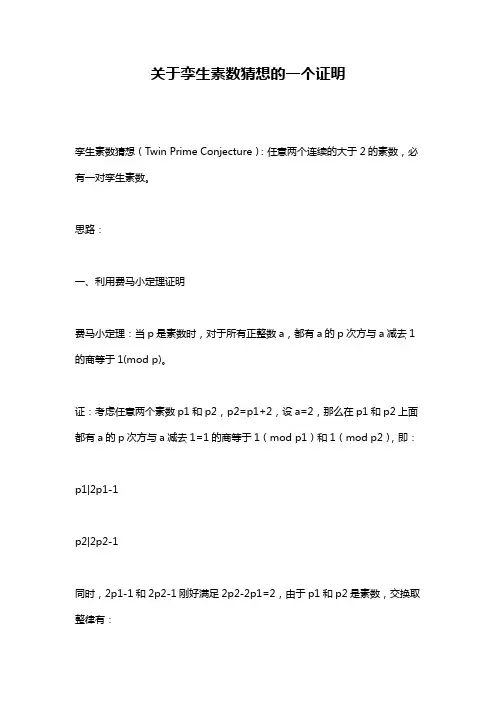
关于孪生素数猜想的一个证明
孪生素数猜想(Twin Prime Conjecture):任意两个连续的大于2的素数,必有一对孪生素数。
思路:
一、利用费马小定理证明
费马小定理:当p是素数时,对于所有正整数a,都有a的p次方与a减去1的商等于1(mod p)。
证:考虑任意两个素数p1和p2,p2=p1+2,设a=2,那么在p1和p2上面都有a的p次方与a减去1=1的商等于1(mod p1)和1(mod p2),即:
p1|2p1-1
p2|2p2-1
同时,2p1-1和2p2-1刚好满足2p2-2p1=2,由于p1和p2是素数,交换取整律有:
2|2p2-2p1
而满足上述等式的唯一解即为p1和p2之和为2。
故证明孪生素数猜想成立。
二、利用数论的方式证明
任意大于2的偶数都可以表示为一对素数之和,即:2n = p1 + p2,其中p1和p2均为素数。
关于这一对素数,存在以下情况:
1、p2 = p1 + 2(孪生素数)
2、p1和p2无任何关系(非孪生素数)
由此可以推出,只要2n=p1+p2成立,那么p1和p2之间必然存在孪生素数对。
故证明孪生素数猜想成立。
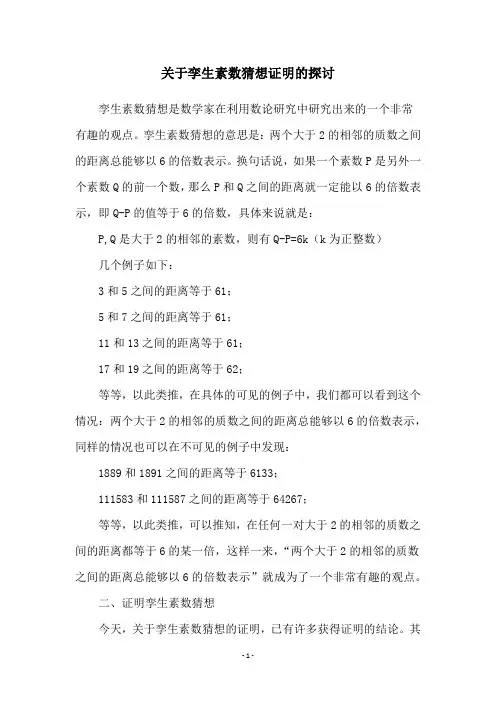
关于孪生素数猜想证明的探讨孪生素数猜想是数学家在利用数论研究中研究出来的一个非常有趣的观点。
孪生素数猜想的意思是:两个大于2的相邻的质数之间的距离总能够以6的倍数表示。
换句话说,如果一个素数P是另外一个素数Q的前一个数,那么P和Q之间的距离就一定能以6的倍数表示,即Q-P的值等于6的倍数,具体来说就是:P,Q是大于2的相邻的素数,则有Q-P=6k(k为正整数)几个例子如下:3和5之间的距离等于61;5和7之间的距离等于61;11和13之间的距离等于61;17和19之间的距离等于62;等等,以此类推,在具体的可见的例子中,我们都可以看到这个情况:两个大于2的相邻的质数之间的距离总能够以6的倍数表示,同样的情况也可以在不可见的例子中发现:1889和1891之间的距离等于6133;111583和111587之间的距离等于64267;等等,以此类推,可以推知,在任何一对大于2的相邻的质数之间的距离都等于6的某一倍,这样一来,“两个大于2的相邻的质数之间的距离总能够以6的倍数表示”就成为了一个非常有趣的观点。
二、证明孪生素数猜想今天,关于孪生素数猜想的证明,已有许多获得证明的结论。
其中最新的研究认为,关于孪生素数猜想的证明可以用幂级数的方法来实现。
具体的做法是:首先,利用幂级数的特性,对素数的距离开启一个幂级数变量,然后分解出几个不同的幂级数,之后,使用数论方法来计算每一个幂级数的解,最后,将所有幂级数的解综合起来,就可以得到关于孪生素数猜想的证明结果。
当然,关于孪生素数猜想的证明,还可以采用其他的方法来实现。
比如,我们也可以利用中国古代的求解素数的方法:分离原理,设立假设,及时观察数字的走向来来实现关于孪生素数猜想的证明。
有了古代求解素数的方法,我们可以从一个素数开始,然后观察,按照古人研究素数的规律,我们可以轻松地推算出每一个素数,最后,通过求差的方法,就可以得出关于孪生素数猜想的证明结果。
三、结论从上面的分析可以看出,关于孪生素数猜想的证明可以采用多种方法来实现,比如,可以采用幂级数方法,也可以使用中国古代的求解素数的方法,不管采用哪种方法来实现,最终的证明结论都是:两个大于2的相邻的质数之间的距离总能够以6的倍数表示。
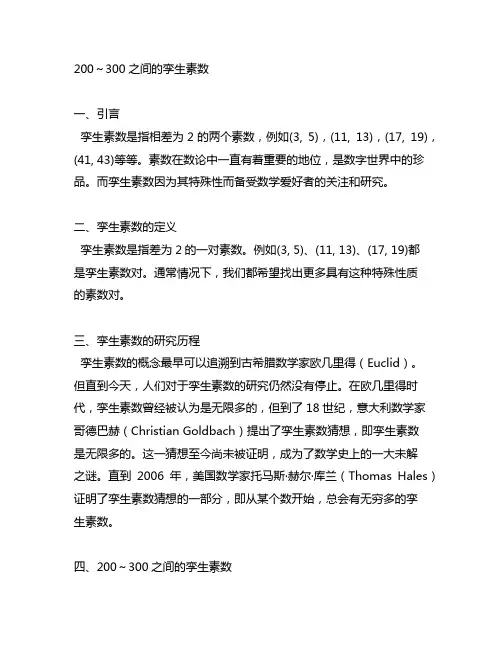
200~300之间的孪生素数一、引言孪生素数是指相差为2的两个素数,例如(3, 5),(11, 13),(17, 19),(41, 43)等等。
素数在数论中一直有着重要的地位,是数字世界中的珍品。
而孪生素数因为其特殊性而备受数学爱好者的关注和研究。
二、孪生素数的定义孪生素数是指差为2的一对素数。
例如(3, 5)、(11, 13)、(17, 19)都是孪生素数对。
通常情况下,我们都希望找出更多具有这种特殊性质的素数对。
三、孪生素数的研究历程孪生素数的概念最早可以追溯到古希腊数学家欧几里得(Euclid)。
但直到今天,人们对于孪生素数的研究仍然没有停止。
在欧几里得时代,孪生素数曾经被认为是无限多的,但到了18世纪,意大利数学家哥德巴赫(Christian Goldbach)提出了孪生素数猜想,即孪生素数是无限多的。
这一猜想至今尚未被证明,成为了数学史上的一大未解之谜。
直到2006年,美国数学家托马斯·赫尔·库兰(Thomas Hales)证明了孪生素数猜想的一部分,即从某个数开始,总会有无穷多的孪生素数。
四、200~300之间的孪生素数针对200~300之间的孪生素数,我们可以通过计算机程序进行搜索和验证。
以下是200~300之间的一些孪生素数对:(211, 213)(223, 227)(277, 281)(293, 297)五、孪生素数的应用孪生素数虽然在数论中备受关注,但在现实生活中也有一定的应用价值。
例如在密码学领域中,孪生素数的特性可以用来构建安全可靠的加密算法,保护数据的安全性。
在计算机科学和信息技术领域,孪生素数也被广泛应用于各种算法和模型中,发挥着重要的作用。
六、结语孪生素数作为数论中一个重要的研究对象,一直以来都备受数学家和爱好者的关注。
在未来的研究中,人们仍然期待能够更深入地挖掘孪生素数的规律和特性,探索其更广泛的应用价值。
也希望有更多的数学爱好者能够加入到孪生素数研究的行列,共同为数学领域的进步做出贡献。
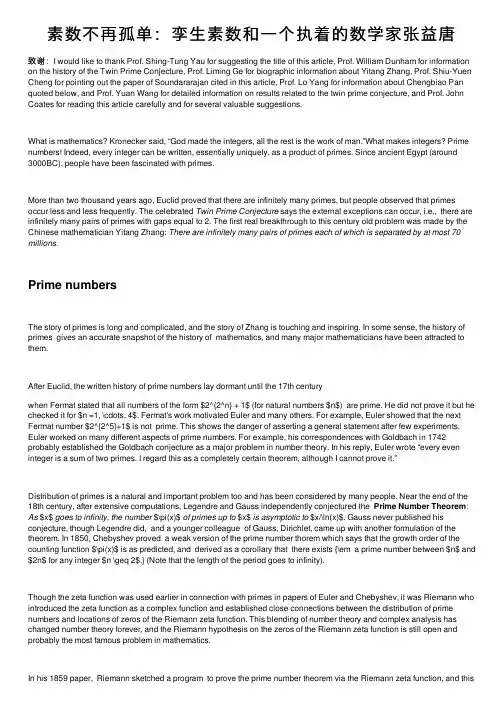
素数不再孤单:孪⽣素数和⼀个执着的数学家张益唐致谢:I would like to thank Prof. Shing-Tung Yau for suggesting the title of this article, Prof. William Dunham for information 致谢on the history of the Twin Prime Conjecture, Prof. Liming Ge for biographic information about Yitang Zhang, Prof. Shiu-Yuen Cheng for pointing out the paper of Soundararajan cited in this article, Prof. Lo Yang for information about Chengbiao Pan quoted below, and Prof. Yuan Wang for detailed information on results related to the twin prime conjecture, and Prof. John Coates for reading this article carefully and for several valuable suggestions.What is mathematics? Kronecker said, “God made the integers, all the rest is the work of man.”What makes integers? Prime numbers! Indeed, every integer can be written, essentially uniquely, as a product of primes. Since ancient Egypt (around 3000BC), people have been fascinated with primes.More than two thousand years ago, Euclid proved that there are infinitely many primes, but people observed that primes occur less and less frequently. The celebrated Twin Prime Conjecture says the external exceptions can occur, i.e., there are infinitely many pairs of primes with gaps equal to 2. The first real breakthrough to this century old problem was made by the Chinese mathematician Yitang Zhang: There are infinitely many pairs of primes each of which is separated by at most 70 millions.Prime numbersThe story of primes is long and complicated, and the story of Zhang is touching and inspiring. In some sense, the history of primes gives an accurate snapshot of the history of mathematics, and many major mathematicians have been attracted to them.After Euclid, the written history of prime numbers lay dormant until the 17th centurywhen Fermat stated that all numbers of the form $2^{2^n} + 1$ (for natural numbers $n$) are prime. He did not prove it but he checked it for $n =1, \cdots, 4$. Fermat's work motivated Euler and many others. For example, Euler showed that the next Fermat number $2^{2^5}+1$ is not prime. This shows the danger of asserting a general statement after few experiments. Euler worked on many different aspects of prime numbers. For example, his correspondences with Goldbach in 1742 probably established the Goldbach conjecture as a major problem in number theory. In his reply, Euler wrote “every even integer is a sum of two primes. I regard this as a completely certain theorem, although I cannot prove it.”Distribution of primes is a natural and important problem too and has been considered by many people. Near the end of the 18th century, after extensive computations, Legendre and Gauss independently conjectured the Prime Number Theorem:As $x$ goes to infinity, the number $\pi(x)$ of primes up to $x$ is asymptotic to $x/\ln(x)$. Gauss never published his conjecture, though Legendre did, and a younger colleague of Gauss, Dirichlet, came up with another formulation of the theorem. In 1850, Chebyshev proved a weak version of the prime number thorem which says that the growth order of the counting function $\pi(x)$ is as predicted, and derived as a corollary that there exists {\em a prime number between $n$ and $2n$ for any integer $n \geq 2$.} (Note that the length of the period goes to infinity).Though the zeta function was used earlier in connection with primes in papers of Euler and Chebyshev, it was Riemann who introduced the zeta function as a complex function and established close connections between the distribution of prime numbers and locations of zeros of the Riemann zeta function. This blending of number theory and complex analysis has changed number theory forever, and the Riemann hypothesis on the zeros of the Riemann zeta function is still open and probably the most famous problem in mathematics.In his 1859 paper, Riemann sketched a program to prove the prime number theorem via the Riemann zeta function, and thisoutline was completed independently by Hadamard and de la Vall\'ee Poussin in 1896.One unusual (or rather intriging, interesting) thing about primes is that they exhibit both regular and irregular (or random ) behaviors. For example, the prime number theorem shows that its overall growth follows a simple function, but gaps between them are complicated and behave randomly (or chaotically). One immediate corollary of the prime number theorem is that gaps between primes go to infinity on average (or the density of primes among integers is equal to zero). Understanding behaviors of these gaps is a natural and interesting problem. (Note that in some ways, this also reflects the difficulty in handling the error terms in the asymptoptics of the counting function $\pi(x)$ of primes, which are related to the zeros of the Riemann zeta function as pointed out by Riemann).Gaps in primesWhat is the history of study on gaps of primes? In 1849, Polignac conjectured that every even integer can occur as gaps of infinitely many pairs of consecutive primes, and the case of 2, i.e., the existence of infinitely many pairs of twin prime pairs, is a special case. The twin prime number in the current form was stated by Glaisher in 1878, who was Second Wrangler in 1871 in Cambridge, a number theorist, the tutor of a famous philosopher Ludwig Wittgenstein, and President of the Royal Astronomical Society. After counting pairs of twin primes among the first few millions of natural numbers, Glaishe concluded:“There can be little or no doubt that the number of prime-pairs is unlimited; but it would be interesting, though probably not easy, to prove this.”These were the first known instances where the twin prime conjecture was stated. Given the simple form and naturalness of the twin prime conjecture, it might be tempting to guess that this question might be considered by people earlier. It might not be a complete surprise if it were considered by the Greeks already. But according to experts on the history of mathematics, in particular on the work of Euler, there was no discussion of twin primes in the work of Euler. Since Euler was broad and well versed in all aspects of number theory, one might conjecture that Polignac was the first person who raised the question on twin primes.This easily stated conjecture on twin primes has been attacked by many people. Though the desired gap 2 is the dream, any estimates on them smaller than the obvious one from the prime number theorem is valuable and interesting, and any description or structure of distribution of these gaps is important and interesting as well1.Many partial and conditional results have been obtained on sizes of gaps between primes, and there are also a lot of numerical work listing twin prime pairs. Contributors to this class of problems include Hardy, Littlewood, Siegel, Selberg, Rankin, Vinogradov, Hua, Erd\"os, Bombieri, Brun, Davenport, Rademacher, R\'enyi, Yuan Wang, Jingrun Chen, Chengdong Pan, Friedlander, Iwaniec, Heath-Brown, Huxley, Maier, Granville, Soundararajan et al. Indeed, it might be hard to name many great analytic number theorists in the last 100 years who have not tried to work on the twin prime conjecture directly or indirectly. Of course, there are many attempts by amateur mathematicians as well.One significant and encouraging result was proved in 2009 by Goldston, Pintz, and Yildirim. In some sense, they started the thaw of the deep freeze. They showed that though gaps between primes can go to infinity, they can be exceptionally small. This is the result of “culminating 80 years of work on this problem” [2, p.1].Under a certain condition called Elliott-Halberstam conjecture on distribution of primes in arithmetic progressions, they can prove that there are infinitely many pairs of primes with gaps less than 16. Though this condition might be “within a hair's breadth” of what is known [1, p. 822], it seems to be hard to check.In [1, p. 822], they raised “Question 1. Can it be proved unconditionally by the current method that there are, infinitely often,bounded gaps between primes?”How to make use of or improve such results? Probably this was the starting point for Zhang. But problems of this kind are hard [1, p. 819]: “Not only is this problem believed to be difficult, but it has also earned the reputation among most mathematicians in the field as hopeless in the sense that there is no known unconditional approach for tackling the problem.”Indeed, difficulties involved seemed insurmountable to experts in the field before the breakthrough by Zhang. According to Soundararajan [4, p. 17]:“First and most importantly, is it possible to prove unconditionally the existence of bounded gaps between primes? As it stands, the answer appears to be no, but perhaps suitable variants of the method will succeed.”The most basic, or the only method, to study prime numbers is the sieve method. But there are many different sieves with subtle differences between them, and it is an art to design the right sieve to attack each problem. Real original ideas were needed to overcome the seeming impasse. After working on the problem for three years, one key revelation occurred to Zhang when he was visiting a friend's house in July 2012, and he solved Question 1 in [1]. In some sense, his persistence and confidence allowed him to succeed at where all world experts failed and gave up.On May 13, 2013, Zhang gave a seminar talk at Harvard University upon the invitation of Prof. Shing-Tung Yau. At the seminar, he announced to the world his spectacular result [5]: There exist infinitely many pairs of primes with gaps less than 70 millions.This marks the end of a long triumphant period in analytic number theory and could be the beginning of a new period, leading to the final solution to the twin prime conjecture.Zhang's careerZhang's academic career is a mingling of the standard and the nonstandard, maybe similar to prime numbers he loves. He went to Beijing University in 1978 and graduated from college as the top student in 1982.2 Then in 1982—1985, he continued to study for the Master degree at Beijing University under Chengbiao Pan and hence was an academic grandson of L.K. Hua3. After receiving a Ph. D. degree at Purdue University in 19924, he could not get a regular academic job and worked in many areas at many places including accounting firms and fast food restaurants. But mathematics has always been his love. From 1999 to 2005, he acted as a substitute or taught few courses at University of New Hamsphire. From 2005 to present, he has been a lecturer there and is an excellent teacher, highly rated by students. In some sense, he has never held as a regular research position in mathematics up to now. It is impressive and touching that he has been continuing to do research on the most challenging problems in mathematics (such as the zeros of the Riemann zeta function and the twin prime conjectures) in spite of the difficult situation over a long period. His persistence has paid off as in the Chinese saying: 皇天不负有⼼⼈ (Heaven never disappoints those determined people, or Heaven helps those who help themselves!)His thesis dealt with the famous Jacobian conjecture on polynomial maps, which is also famous for many false proofs and is still open. After obtaining his Ph. D. degree and before this breakthrough on twin primes, Zhang published only one paper, ``On the zeros of $\zeta'(s)$ near the critical line" [3] in the prestigous Duke Journal of Mathematics, which studies zeroes of the Riemann zeta function and its derivative and gaps between the zeros. In 1985, Zhang published another paper on zeros of the Riemann zeta function in Acta Mathematica Sinica, one of the leading mathematics journals in China.It is perhaps helpful to point out that spacing of these zeros and twin primes are closely related [4, p. 2]: ``Precise knowledge of the frequency with which prime pairs $p$ and $p + 2k$ occur (for an even number $2k$) has subtle implications for the distribution of spacings between ordinates of zeros of the Riemann zeta-function.... Going in the other direction, weird (and unlikely) patterns in zeros of zeta-like functions would imply the existence of infinitely many twin primes."In the current culture of mass production of everything, probably one sobering question is how much one should or can really produce. (This reminds one the famous short story by Tolsty, ``How much land does a man need?" One can also replace “land” by other attractive items, and “much” by “many”.)Is counting papers and number of pages an effective criterion? Probably one should also keep in mind that the best judgment on everything under the Sun is still the time!Maybe not everyone is familiar with the Riemann hypothesis, but every student who has studied calculus will surely have heard of Riemann and his integrals. Many mathematicians will agree that Riemann is one of the greatest mathematicians, if not the greatest mathematician, in the history. But it is probably less known that in his life time, Riemann only published 5 papers in mathematics together with 4 more papers in physics. (Galois published fewer papers in his life time, but he never worked as a full time mathematician and died at a very young, student age.)Primes are not lonersThe concept of primes is also a sentimental one. Primes are lonely numbers among integers, but for some primes (maybe also for some human beings), one close partner as in twin prime pairs is probably enough and the best. This sentiment is well described in the popular novel, “The Solitude of Prime Numbers '' by Paolo Giordano. Let us quote one paragraph from this book:Primes “are suspicious, solitary numbers, which is why Mattia [the hero of the novel] thought they were wonderful. Sometimes he thought that they had ended up in that sequence by mistake, that they'd been trapped, like pearls strung on a necklace. Other times he thought that they too would have preferred to be like all the others, just ordinary numbers, but for some reasons they couldn't do it....among prime numbers, there are some that are even more special. Mathematicians call them twin primes: pairs of prime numbers that are close to each other, almost neighbors, but between them there is always an even number that prevents them from touching.”Zhang reminds one of the heroes of several generations of Chinese students, Jingrun Chen, and his work on the famous Goldbach conjecture. Chen and Zhang both worked persistently and lonely on deep problems in number theory, and they both brought glory to China, in particular, to the Chinese mathematics community.Of course, the story of Jingrun Chen is well-known to almost every Chinese student (young now and then). For a romantic rendition of a mathematician's pursuit of the Goldbach conjecture, one might enjoy reading the book Uncle Petros and Goldbach's Conjecture: A Novel of Mathematical Obsession by Apostolos Doxiadis. (Incidentally, the hero in this novel, Uncle Petro, published only one paper after his Ph. D. degree and before he switched to work on the Goldbach conjecture.) References[1] D. Goldston, J. Pintz, C. Yldrm, Primes in tuples. I., Ann. of Math. (2)170 (2009), no. 2, 819--862.[2] D. Goldston, J. Pintz, C. Yldrm, Primes in tuples. II., Acta Math.204 (2010), no. 1, 1--47.[3] Y. Zhang, On the zeros of $\zeta'(s)$ near the critical line, Duke Math. J.110 (2001), no. 3, 555--572.[4] K. Soundararajan, Small gaps between prime numbers: the work of Goldston-Pintz- Yldrm, Bull. Amer. Math. Soc. (N.S.)44 (2007), no. 1, 1--18.[5] Y. Zhang, Bounded gaps between primes, preprint, 2013, 56 pages.1 The problem on spacing between prime numbers is one of several problems concerning spacing in naturally occurring sequences such as zeros of the Riemann zeta-function, energy levels of large nuclei, the fractional parts of $\sqrt{n}$ for $ n \in \mathbf N$. One question asks whether the spacings can be modelled by the gaps between random numbers (or eigenvalues of randomly chosen matrices), or whether they follow other more esoteric laws.2This seems to the unanimous opinion of former students from Beijing University who knew him.3Though Chengbiao Pan was not a student of Hua formally, but the influence of Hua on Pan was huge and clearly visible. According to Prof. L. Yang, ``Chengbiao Pan was a undergraduate student in PKU (1955-1960). He worked, after 1960, in Beijing Agriculture Machine College, and became a professor of Beijing Agricultute University in the eighties, after his college was combined in this university. Though Pan was the professor of Beijing Agriculture University, he spent most time in PKU. Pan was a student of Prof. Min, but not studying the number theory. Instead of, Pan studied the generalized analytic functions (the Russian mathematician Vekywa and L. Bers), since Prof. Min had to change his field to this in 1958.) I believe that Pan's knowledge and ability on number theory was mainly from his older brother PAN Chengdong. Pan Chengdong was the graduate student of Prof. Min (1956-1959). But Pan Chengdong was also considered to be the student of Prof. Hua, especially on the research of Goldbach conjecture. Even Prof. Min, was much influenced by Prof. Hua."4Around 1984, Prof. Shing-Tung Yau tried to arrange Zhang to go to UC San Diego to study with the well-known analytic number theorist Harold Stark there. Unfortunately, for some reasons this idea was vetoed. Otherwise he might move academically along a path which is closer to a geodesic.张益唐近照。
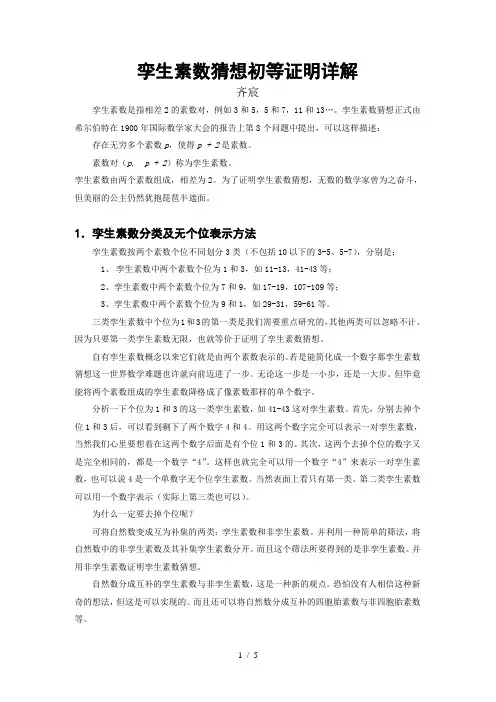
孪生素数猜想初等证明详解齐宸孪生素数是指相差2的素数对,例如3和5,5和7,11和13…。
孪生素数猜想正式由希尔伯特在1900年国际数学家大会的报告上第8个问题中提出,可以这样描述:存在无穷多个素数p,使得p + 2是素数。
素数对(p, p + 2)称为孪生素数。
孪生素数由两个素数组成,相差为2。
为了证明孪生素数猜想,无数的数学家曾为之奋斗,但美丽的公主仍然犹抱琵琶半遮面。
1.孪生素数分类及无个位表示方法孪生素数按两个素数个位不同划分3类(不包括10以下的3-5、5-7),分别是:1、孪生素数中两个素数个位为1和3,如11-13,41-43等;2、孪生素数中两个素数个位为7和9,如17-19,107-109等;3、孪生素数中两个素数个位为9和1,如29-31,59-61等。
三类孪生素数中个位为1和3的第一类是我们需要重点研究的,其他两类可以忽略不计。
因为只要第一类孪生素数无限,也就等价于证明了孪生素数猜想。
自有孪生素数概念以来它们就是由两个素数表示的。
若是能简化成一个数字那孪生素数猜想这一世界数学难题也许就向前迈进了一步。
无论这一步是一小步,还是一大步。
但毕竟能将两个素数组成的孪生素数降格成了像素数那样的单个数字。
分析一下个位为1和3的这一类孪生素数,如41-43这对孪生素数。
首先,分别去掉个位1和3后,可以看到剩下了两个数字4和4。
用这两个数字完全可以表示一对孪生素数,当然我们心里要想着在这两个数字后面是有个位1和3的。
其次,这两个去掉个位的数字又是完全相同的,都是一个数字“4”。
这样也就完全可以用一个数字“4”来表示一对孪生素数,也可以说4是一个单数字无个位孪生素数。
当然表面上看只有第一类、第二类孪生素数可以用一个数字表示(实际上第三类也可以)。
为什么一定要去掉个位呢?可将自然数变成互为补集的两类:孪生素数和非孪生素数。
并利用一种简单的筛法,将自然数中的非孪生素数及其补集孪生素数分开。
而且这个筛法所要得到的是非孪生素数。
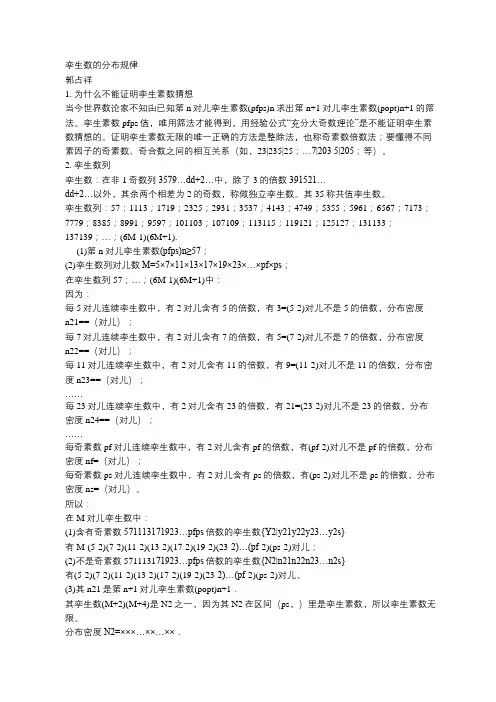
孪生数的分布规律郭占祥1. 为什么不能证明孪生素数猜想当今世界数论家不知由已知第n对儿孪生素数(pfps)n求出第n+1对儿孪生素数(popt)n+1的筛法。
孪生素数pfps值,唯用筛法才能得到,用经验公式“充分大奇数理论”是不能证明孪生素数猜想的。
证明孪生素数无限的唯一正确的方法是整除法,也称奇素数倍数法;要懂得不同素因子的奇素数、奇合数之间的相互关系(如,23|235|25;…7|203 5|205;等)。
2. 孪生数列孪生数:在非1奇数列3579…dd+2…中,除了3的倍数391521…dd+2…以外,其余两个相差为2的奇数,称做独立孪生数。
其35称共值孪生数。
孪生数列:57;1113;1719;2325;2931;3537;4143;4749;5355;5961;6567;7173;7779;8385;8991;9597;101103;107109;113115;119121;125127;131133;137139;…;(6M-1)(6M+1).(1)第n对儿孪生素数(pfps)n≥57;(2)孪生数列对儿数M=5×7×11×13×17×19×23×…×pf×ps;在孪生数列57;…;(6M-1)(6M+1)中:因为:每5对儿连续孪生数中,有2对儿含有5的倍数,有3=(5-2)对儿不是5的倍数,分布密度n21==(对儿);每7对儿连续孪生数中,有2对儿含有7的倍数,有5=(7-2)对儿不是7的倍数,分布密度n22==(对儿);每11对儿连续孪生数中,有2对儿含有11的倍数,有9=(11-2)对儿不是11的倍数,分布密度n23==(对儿);……每23对儿连续孪生数中,有2对儿含有23的倍数,有21=(23-2)对儿不是23的倍数,分布密度n24==(对儿);……每奇素数pf对儿连续孪生数中,有2对儿含有pf的倍数,有(pf-2)对儿不是pf的倍数,分布密度nf=(对儿);每奇素数ps对儿连续孪生数中,有2对儿含有ps的倍数,有(ps-2)对儿不是ps的倍数,分布密度ns=(对儿)。
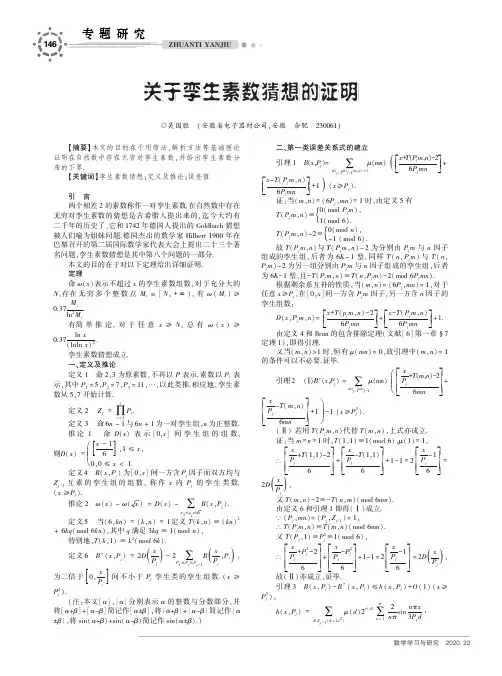
关于孪生素数猜想的证明关于孪生素数猜想的证明Һ吴国胜㊀(安徽省电子器材公司,安徽㊀合肥㊀230061)㊀㊀ʌ摘要ɔ本文的目的在于用筛法㊁解析方法等基础理论证明在自然数中存在无穷对孪生素数,并给出孪生素数分布的下界.ʌ关键词ɔ孪生素数猜想;定义及推论;误差值引㊀言两个相差2的素数称作一对孪生素数.在自然数中存在无穷对孪生素数的猜想是古希腊人提出来的,迄今大约有二千年的历史了,它和1742年德国人提出的Goldbach猜想被人们喻为姐妹问题.德国杰出的数学家Hilbert1900年在巴黎召开的第二届国际数学家代表大会上提出二十三个著名问题,孪生素数猜想是其中第八个问题的一部分.本文的目的在于对以下定理给出详细证明.定理命ω(x)表示不超过x的孪生素数组数,对于充分大的N,存在无穷多个整数点Miɪ[N,+ɕ),有ω(Mi)ȡ0.37Miln2Mi.有简单推论,对于任意xȡN,总有ω(x)ȡ0.37lnx(lnlnx)2.孪生素数猜想成立.一㊁定义及推论定义1㊀命2,3为原素数,不再以P表示.素数以Pi表示,其中P1=5,P2=7,P3=11, ,以此类推.相应地,孪生素数从5,7开始计算.定义2㊀Zj=ᵑji=1Pi.定义3㊀命6n-1与6n+1为一对孪生组,n为正整数.推论1㊀命D(x)表示[0,x]间孪生组的组数,则D(x)=x-16[],1ɤx,0,0ɤx<1.æèçç定义4㊀B(x,Pj)为[0,x]间一方含Pj因子而双方均与Zj-1互素的孪生组的组数,称作x内Pj的孪生类数.(xȡPj).推论2㊀ω(x)-ω(x)=D(x)-ðp1ɤpjɤxB(x,Pj).定义5㊀当(6,kn)=(k,n)=1定义T(k,n)ʉ(kn)2+6kq(mod6kn),其中q满足3kqʉ1(modn),特别地,T(k,1)ʉk2(mod6k).定义6㊀B∗(x,Pj)=2DxPj()-2ðP1ɤPiɤPj-1BxPj,Pi(),为二倍于0,xPj[]间不小于Pj孪生类的孪生组数.(xȡP2j).(注:本文[α],{α}分别表示α的整数与分数部分,并将[α+β]+[α-β]简记作[αʃβ],将{α+β}+{α-β}简记作{αʃβ},将sin(α+β)+sin(α-β)简记作sin(αʃβ).)二㊁第一类误差关系式的建立引理1㊀B(x,Pj)=ðn|zj-1m|zj-1(m,n)=1μ(mn)(x+T(Pjm,n)-26Pjmnéëêùûú+x-T(Pjm,n)6Pjmnéëêùûú+1)(xȡPj).证:当(m,n)=(6Pj,mn)=1时,由定义5有T(Pjm,n)ʉ0(modPjm),1(mod6).{T(Pjm,n)-2ʉ0(modn),-1(mod6).{故T(Pjm,n)与T(Pjm,n)-2为分别由Pjm与n因子组成的孪生组,后者为6K-1型,同样T(n,Pjm)与T(n,Pjm)-2为另一组分别由Pjm与n因子组成的孪生组,后者为6K-1型,且-T(Pjm,n)ʉT(n,Pjm)-2(mod6Pjmn).根据剩余系互补的性质,当(m,n)=(6Pj,mn)=1,对于任意xȡPj,在[0,x]间一方含Pjm因子,另一方含n因子的孪生组数:D(x,Pjm,n)=x+T(pjm,n)-26Pjmnéëêùûú+x-T(Pjm,n)6Pjmnéëêùûú+1.由定义4和Brun的包含排除定理(文献[6]第一章ɦ7定理1),即得引理.又当(m,n)>1时,恒有μ(mn)=0,故引理中(m,n)=1的条件可以不必要.证毕.引理2㊀(Ⅰ)B∗(x,Pj)=ðn|zj-1m|zj-1μ(mn)æèççxPj+T(m,n)-26mnéëêêêùûúúú+xPj-T(m,n)6mnéëêêêùûúúú+1öø÷÷-1(xȡP2j).(Ⅱ)若用T(Pjm,n)代替T(m,n),上式亦成立.证:当m=n=1时,T(1,1)ʉ1(mod6),μ(1)=1,ʑxPj+T(1,1)-26éëêêêùûúúú+xPj-T(1,1)6éëêêêùûúúú+1-1=2xPj-16éëêêêùûúúú=2DxPj(),又T(m,n)-2ʉ-T(n,m)(mod6mn).由定义6和引理1即得(Ⅰ)成立.ȵ(Pj,mn)=(Pj,Zj-1)=1,ʑT(Pjm,n)ʉT(m,n)(mod6mn).又T(Pj,1)ʉP2jʉ1(mod6),ʑxPj+P2j-26éëêêêùûúúú+xPj-P2j6éëêêêùûúúú+1-1=2xPj-16éëêêêùûúúú=2DxPj(),故(Ⅱ)亦成立,证毕.引理3㊀B(x,Pj)-B∗(x,Pj)ɤh(x,Pj)+O(1)(xȡP2j),h(x,Pj)=ðd|Zj-1(d<4x2)μ(d)2v(d)ðɕn=12nπsinnπx3Pjd㊃cosnπT(Kξ)3Pjd-cosnπT(Kξ)3dæèçöø÷,其中T(Kξ)=TPjKξ,Zj-1Kξæèçöø÷,Kξ为Ki|Zj-1之某一值,v(d)表示d的不同素因子的个数,v(1)=0.证:命φ表示Ki|Zj-1的集合,因Zj-1无重复素因子,故对于任一Zj-1,Ki之集合有且仅有ðj-1k=1Ckj-1=2j-1个元素组成,当(l1,l2)=(l1,6Pjmn)=(l2,6Pjmn)=1,有T(l1Pjm,l2n)ʉT(Pjm,n)(mod6Pjmn).由引理1,2即可得到:B(x,Pj)-B∗(x,Pj)=ðKi|Zj-112j-1ðd|Zj-1μ(d)2v(d)㊃æèççx+T(Ki)-26Pjdéëêùûú+x-T(Ki)6Pjdéëêùûú-xPj+T(Ki)-26déëêêêùûúúú-xPj-T(Ki)6déëêêêùûúúúöø÷÷+1,(1)现估计(1)式中第一㊁三两项中消去-2后所产生的误差R=R1+R3,命Ai=x+T(Ki)有:Ai-26Pjdéëêùûú=[Ai]-26Pjdéëêùûú=Ai6Pjdéëêùûú-1,当[Ai]ʉ0或1(mod6Pjd),Ai6Pjdéëêùûú,其他.ìîíïïïï故知只有当[Ai]=6PjMiDi+δ(δ=0或1,其中Di|Zj-1)时才产生误差,根据同余的性质有:ðd|Diμ(d)2v(d)=1,v(Di)为偶数或0,-1,v(Di)为奇数,{ʑR1ɤ12j-1ðKi|Zj-11=1,同样可证得|R3|ɤ1.ʑ|R|ɤ|R1|+|R3|ɤ2,故由(1)式知必定存在某一Kξ|Zj-1,使得:B(x,Pj)-B∗(x,Pj)ɤh(x,Pj)+O(1),其中h(x,Pj)=ðd|Zj-1μ(d)2v(d)æèççxʃT(kξ)6Pjdéëêùûú-xPjʃT(Kξ)6déëêêêùûúúúöø÷÷,ȵPjKξ|T(Kξ),Zj-1Kξ|T(Kξ)-2,(注:以下将T(Kξ)简记作T)ʑd|Zj-1|T(T-2).因d无重复素因子,故知对于任意d,当dȡ4x2可分解为d=d1d2,其中d2ȡd1ȡ1,使d2|T或者d2|(T-2)两者之一成立.显然d2ȡ2x>x+2Pj(xȡP2j),如d2|T成立,有0<xd2=β<1,Td2=L,显然(6,L)=1,因而-L6q[]=-1-L6q[](q为正整数),故有:xʃT6Pjd[]-xPjʃT6déëêêêùûúúú=βʃL6Pjd1[]-βʃPjL6Pjd1éëêùûú=ʃL6Pjd1[]-ʃL6d1[]=0,同样如d2|(T-2),则有0<x+2d2=β1<1,0<x-2d2=β2<1,0<x+2Pjd2=β3<1,0<x-2Pjd2=β4<1,T-2d2=L,则(6,L)=1,即有xʃT6Pjd[]-xPjʃT6déëêêêùûúúú=β1+L6Pjd1éëêùûú+β2-L6Pjd1éëêùûú-β3+PjL6Pjd1éëêùûú-β4-PjL6Pjd1éëêùûú=ʃL6Pjd1[]-ʃL6d1[]=0,ʑh(x,Pj)=ðd|Zj-1(d<4x2)μ(d)2v(d)xʃT6Pjd[]-xʃPjT6Pjdéëêùûúæèçöø÷=ðd|Zj-1(d<4x2)μ(d)2v(d)xʃPjT6Pjd{}-xʃT6Pjd{}æèçöø÷,(2)由Fourier展开式,当{α}ʂ0时有:{α}=-ðɕn=11nπsin(2nπα)+12,(3)ȵPj|T,ʑ只需取x,当Pj|x,即有(2)式中任意一项{αi}ʂ0均适用于(3)式,故(2)式又可表示为:h(x,Pj)=ðd|Zj-1(d<4x2)μ(d)2v(d)ðɕn=12nπsinnπx3Pjd(cosnπT3Pjd-cosnπT3d),证毕.三、第一类误差值的计算引理4㊀用M[F1(y)]表示函数F1(y)的Mellin变换式,若有M[F1(y)]=ðd|Zj-1(d<4x2)μ(d)2v(d)ds-2(ζ(2-s)-1)(s-1),取σ=ReS=1-1lny,当y>Pj时,必有|F1(y)|=Oln2Pjylnyæèçöø÷.证:σ=1-1lny>1-1lnPj>0.首先证明M[F1(y)]绝对收敛.令H(s)=ðd|Zj-1(d<4x2)μ(d)2v(d)ds-2,(4)则H(s)ɤðd|Zj-2|μ(d)|2v(d)|ds-2|=ᵑP|Zj-1(1+2Pσ-2),ʑln|H(s)|ɤlnᵑP|Zj-1(1+2Pσ-2)=ðP1ɤPɤPj-1ln(1+2P-1-1lny)ɤðP1ɤPɤPj-12P-1=2lnlnPj+O(1).(参见文献[2]第七章ɦ3Mertens公式)ʑ|H(s)|=Ο(ln2Pj)绝对收敛.又Re(2-s)=1+1lny>1,令b1(u)={u}-12,有ζ(2-s)=11-s+12-(2-s)ʏɕ1b1(u)u3-sdu=-1s-1+1+ʏɕ1{u}dus-2,(参考文献[1]第八章ɦ2)ʏɕ1{u}dus-2为{u}ʂ0时的瑕积分,记作P㊃V.P㊃Vʏɕ1{u}dus-2={u}us-2ɕ1-P㊃Vʏɕ1us-2d{u}=-P㊃Vʏɕ1us-2d{u}dudu,当{u}ʂ0,由(3)式有d{u}du=-2ðɕn=1cos(2nπu)=-limλңɕsinλ+12()2πusinπu+1,(参考文献[7](3.6.1)式)综上即得:Q=(ζ(2-s)-1)(s-1)=-1+(s-1)P㊃Vʏɕ1us-2limλңɕsinλ+12()2πusinπu-1æèççöø÷÷du=-1+P㊃Vʏɕ1(limλңɕsinλ+12()2πusinπu-1)dus-1=P㊃Vʏɕ1limλңɕsinλ+12()2πusinπudus-1,ʑ|Q|ɤP㊃Vʏɕ1|limλңɕsinλ+12()2πusinπu|㊃|dus-1|=|limλңɕsinλ+12()2πξsinπξ|ʏɕ1du-1lny|ɤ1sinπξ<+ɕ({ξ}ʂ0),ʑM[F1(y)]绝对收敛.令ʏ(σ)=limAңɕʏσ+iAσ-iA,由文献[1]第十二章ɦ1引理1有:F1(y)=12πiʏ(σ)M[F1(y)]y-sds=12πiʏ(σ)H(s)(ζ(2-s)-1)(s-1)y-sds=-12πiʏ(σ)H(s)(ζ(2-s)-1)dy-s+1dyds=i2πʏ(σ)H(s)(ζ(2-s)-1)dsdydy-s+1.ȵζ(2-s)-1=ðɕn=21n2-s,ʑ|ζ(2-s)-1|ɤðɕn=21n1+1lny=ʏɕ1duu1+1lny+O(1)=-lny㊃u-1lnyɕ1+O(1)=lny+O(1),dsdy=d1lnydy=1yln2y,|yit|=|eitlny|=1,y-σ+1=y1lny=e.当y>Pj,lny>lnPj≫1,ʑ|F1(y)|ɤʏ(σ)|H(s)||ζ(2-s)-1|dsdy|dy-s+1|ɤʏ(σ)O(ln2Pj)(lny+O(1))1yln2ydy1lny=Oln2Pjylnyæèçöø÷,证毕.引理5㊀对于充分大的x,恒有B(x,Pj)-B∗(x,Pj)ɤOxln3PjP2jæèçöø÷+O(1),当Pjɤx12时,误差项O(1)可以不计.证:(Ⅰ)当Pjɤ6lnx时,ȵðɕn=12nπsinnπαcosnπβɤ1,又v(P)=1,由引理3有:h(x,Pj)ɤ2ðd|Zj-1|μ(d)|2v(d)=2ᵑP|Zj-1(1+2v(P))=2㊃3j-1.由素数定理得j=π(Pj)=PjlnPj1+O1lnPj()().ʑB(x,Pj)-B∗(x,Pj)ɤ2㊃3j-1+O(1)<3jɤ37lnxlnlnx=x7ln3lnlnx<x12≪xln3PjP2j.(Ⅱ)当x12<Pjɤx,显然有B(x,Pj)-B∗(x,Pj)=B(x,Pj)=1,Pj与Pj+2为孪生素数,0,其他.{(Ⅲ)现着重讨论6lnx<Pjɤx12的情形.由引理3我们有:㊀h(x,Pj)=ðd|Zj-1(d<4x2)μ(d)2v(d)ðɕn=14nπ㊃nπd㊃sinnπx3PjdʏT6T6Pjsin2nπqddq=ʏT6T6Pjðd|Zj-1(d<4x2)μ(d)2v(d)ðɕn=12d(cosq-x6Pjd2nπ-cosq+x6Pjd2nπ)dq=ʏT6T6Pjʏq+x6Pjq-x6Pj(ðd|Zj-1(d<4x2)μ(d)2v(d)ðɕn=14nπd2sin2nπdy)dydq=ʏT6T6Pjʏq+x6Pjq-x6PjF(y)dydq.由积分不等式,当b>aȡ0时,若在区间[a,b]上f(x),g(x)可积,|f(x)|ɤ|g(x)|,则有ʏbaf(x)dxɤʏba|f(x)|dxɤʏba|g(x)|dx.又F(y)可积,则有:h(x,Pj)ɤʏT6T6Pjʏq+x6Pjq-x6PjF(y)dydq,(5)F(y)是实连续函数,y>0(见(9)式),我们可对其取Mellin变换,令ReS=1-1lny,当α>0时,M[sinαx]=ʏɕ0sinαx㊃xs-1dx=α-sΓ(s)sinπs2,ʑM[F(y)]=ðd|Zj-1(d<4x2)μ(d)2v(d)ðɕn=1(nπ)1-s22-sΓ(s)ds-2sinπs2,(6)ðɕn=1n1-s=ζ(s-1),Γ(s)=(s-1)Γ(s-1)(文献[5]第二章ɦ2定理2),sinπs2=cosπ(s-1)2.根据RiemannZeta函数解析开拓的性质(文献[3]第二篇第二章ɦ2定理2.1)有ζ(1-s)=21-sπ-scosπs2Γ(s)ζ(s)普遍成立.ʑ由(6)式和(4)式有:M[F(y)]=ζ(s-1)Γ(s-1)(s-1)π1-s22-sH(s)㊃cosπ(s-1)2=ζ(2-s)(s-1)H(s),令F(y)=F1(y)+F2(y),则M[F(y)]=M[F1(y)]+M[F2(y)],其中M[F1(y)]=(ζ(2-s)-1)(s-1)H(s),(7)M[F2(y)]=(s-1)H(s),相应地,h(x,Pj)=h1(x,Pj)+h2(x,Pj),首先证明h2(x,Pj)=0.ȵPjKξT,Zj-1Kξ(T-2)(见引理3),ʑTȡPjKξ,T-2ȡZj-1Kξ,T2>T(T-2)ȡPjKξ㊃Zj-1Kξ=PjZj-1=Zj,T>Zj(注:当xȡP2j,必有d通过所有PɤPj-1,故(5)式中T不变.)由文献[1]第三章ɦ1定理2契贝谢夫θ函数性质有:lnT>12lnZj>12-ε()Pjȡ12-ε()6lnx>2.8lnx,即有1lnT=O1Pj(),(8)及T>x2.8,又xȡP2j,由(5)式知yȡq-x6PjȡT-x6Pj>x2.8-x6x≫x2.2≫4x2,(9)h2(x,Pj)=ʏT6T6Pjʏq+x6Pjq-x6PjF2(y)dydq=(ʏɕT-x6Pj-ʏɕT-xPj6-ʏɕT+x6Pj+ʏɕT+xPj6)ʏɕφF2(η)dηdφ,由Mellin变换公式(文献[8]581页),若M[f(y)]=M(s),则有:M[ʏɕyf(φ)dφ]=M(s+1)s成立,由此推出:M[ʏɕyʏɕφf(η)dηdφ]=M(s+2)(s+1)s成立.令U(y)=ʏɕyʏɕφF2(η)dηdφ,由M[F2(y)]=(s-1)H(s)得到M[U(y)]=(s+2-1)H(s+2)(s+1)s=1sH(s+2),由(9)式y≫4x2,即σ=1-1lny>0,因而|M[U(y)]|=1σ+itH(2+σ+it)ɤðd|Zj-1|μ(d)|2v(d)dσ1σ+it=1σ2+t2ðd|Zj-1|μ(d)|2v(d)dσ<+ɕ绝对收敛.即有:U(y)=12πiʏσ+iɕσ-iɕM[U(y)]y-sds=12πiʏσ+iɕσ-iɕðd|Zj-1(d<4x2)μ(d)2v(d)1sdy()sds,根据Mellin变换表(文献[8]582页)有12πiʏσ+iɕσ-iɕ1sαy()sds=1(y<α),0(y>α),{(σ>0)由(9)式得y>4x2>d,ʑU(y)=0,即可得到h2(x,Pj)的各项积分均为0,ʑh2(x,Pj)=0.又F1(y)满足引理4的条件,由(5)式有:h(x,Pj)=h1(x,Pj)ɤOʏT6T6Pjʏq+x6Pjq-x6Pjln2Pjylnydydqæèçöø÷=Oln2PjʏT6T6Pjlnlnq+x6Pj()lnq-x6Pj()dqæèçççöø÷÷÷=Oxln2PjPjʏT6T6Pjdqqlnqæèçöø÷=Oxln2PjPjlnlnT6lnT6Pjæèçççöø÷÷÷=Oxln3PjPjlnTæèçöø÷=Oxln3PjP2jæèçöø÷.注1:上式中,lnlnq+x6Pj()lnq-x6Pj()=lnlnq+ln1+x6qPj()lnq+ln1-x6qPj()=Oln1+1lnqln1+x6qPj()()()=O1lnqln1+x6qPj()()=O1lnq㊃x6qPj()=OxPjqlnq().注2:上式中,lnlnT6lnT6qPj=lnlnT6lnT6+ln1Pj=ln11-lnPjlnT6=Oln1+lnPjlnT6æèççöø÷÷æèççöø÷÷=OlnPjlnTæèçöø÷.最后一步用到(8)式,综上即得到引理.证毕.四㊁函数G(u)的性质引理6若G(u)满足方程G(u)=1u2,㊀㊀㊀㊀㊀㊀1ɤuɤ2,㊀㊀㊀㊀(10)(u2G(u))ᶄ=2uG(u-1),u>2,(11){则G(u)为连续函数,对于任意uȡ1,恒有14ɤG(u)ɤ1.证:令G(u)=G1(u)+G2(u),其中G1(u),G2(u)满足方程:G1(u)=1u2,G2(u)=0,㊀1ɤuɤ2,(u2G1(u))ᶄ=2uG2(u-1),(u2G2(u))ᶄ=2uG1(u-1),u>2,{解之即知G1(u),G2(u)均为连续函数,故G(u)为连续函数.由(10)式知,当1ɤuɤ2时,有14ɤG(u)ɤ1成立.用数学归纳法证明,当u>2时,也有14ɤG(u)ɤ1.由(11)式即得:u2G(u)-22G(2)=2ʏu2tG(t-1)dtɤ2ʏu2tdt=u2-22,ʑG(u)ɤ1-3u2ɤ1.又u2G(u)-22G(2)=2ʏu2tG(t-1)dtȡ12ʏu2tdt=14(u2-22)=14u2-1,ʑG(u)ȡ14.证毕.五、定理的反证1.在假设基础上得到的结果(第二类误差值的计算)引理7㊀对于充分大的N,当yȡN时,假设恒有ω(y)<Cyln2y㊀(12)成立,C=0.37,则当x12ȡPjȡlnxȡN时,恒有B(x,Pj)<2CG(u)xPjln2Pj+OxPjln3Pjæèçöø÷成立,其中Pj=x1u+1,即u=lnxlnPj-1.证:用数学归纳法证明.当N充分大,PjȡN时,有Pjȡln7Pj,故有xP2jln3PjɤxPjln4Pj.当x12ȡPjȡx13(1ɤuɤ2)时,由(12)式,引理5,定义6及推论2有:B(x,Pj)ɤB∗(x,Pj)+OxP2jln3Pjæèçöø÷=2ωxPj()-2ω(Pj-1)+OxPjln4Pjæèçöø÷<2CxPjln2xPj()+OxPjln4Pjæèçöø÷=2CxPj(lnxuu+1)2+OxPjln4Pjæèçöø÷=2Cxu2Pjln2Pj+OxPjln3Pjæèçöø÷,即知当1ɤuɤ2时,G(u)=1u2,引理成立.若x1k-1ȡPjȡx1k,kȡ3(即k-2ɤuɤk-1),引理成立,则当x1kȡPjȡx1k+1,k-1ɤuɤk时由引理5及推论2有:B(x,Pj)ɤB∗(x,Pj)+OxP2jln3Pjæèçöø÷=2ðPjɤPiɤxPj()12BxPj,Pi()+2ωxPj()-2ωxPj()12()+OxPjln4Pjæèçöø÷.此处着重说明:在以上递推计算中每项都有一个差式,如记作ω+i-ω-i,易见对于每个差式,恒有ω+iȡω-iȡω(Pj),故参加递推和式计算之ω(t)均符合引理假设的条件,即:ωxPj()ȡω(t)ȡω(Pj)ȡω(lnx)ȡω(N).又x1k+1ɤPj,ʑxɤPk+1j,即有xPj()1kɤPjɤPiɤxPj()12.因而可由已知递推得:B(x,Pi)<4CðPjɤPiɤxPj()12GlnxPjlnPi-1æèççöø÷÷xPjPiln2Pi+OðPjɤPiɤxPj()122xPjPiln3Piæèçöø÷+2CxPjln2xPj()+OxPjln4Pjæèçöø÷,(13)用Abel恒等式计算:Ω=ðPjɤPiɤxPj()12GlnxPjlnPi-1æèççöø÷÷1Piln2Pi,在文献[1]第三章ɦ1引理2中取A(t)=ðPɤtlnPP,当tȡPjȡlnx充分大时,由文献[1]第四章命题(C)式有:A(t)=ðnɤtΛ(n)n-ðmȡ2ðPɤt1mlnPPm=lnt-γ+O(1)-E(t),其中γ为Euler常数,E(t)=ðmȡ2ðPlnPPm-ðmȡ2ðP>t1mlnPPm=α1+Oʏɕtlnqq2dqæèçöø÷=α1+Olnttæèçöø÷=α1+O(1),ʑA(t)=lnt-α+O(1),ȵα1,γ均为与t无关的常数,ʑα亦为与t无关之常数.令H(t)=lnt,r(t)=-α+O(1),f(t)=GlnxPjlnt-1æèççöø÷÷1ln3t.ȵH(t)连续可微,及14ɤG(u)ɤ1,由文献[1]第三章ɦ1引理2即可得到:Ω=ʏxPj()12PjGlnxPjlnt-1æèççöø÷÷dttln3t+RxPj()12,Pj()其中RxPj()12,Pj()=rxPj()12()fxPj()12()-r(Pj)f(Pj)-ʏxPj()12Pjr(t)fᶄ(t)dt=OfxPj()12()+O(f(Pj))+OʏxPj()12Pjfᶄ(t)dt()=O1ln3Pjæèçöø÷.故由(13)式即有:B(x,Pi)<4CxPjʏxPj()12PjGlnxPjlnt-1æèççöø÷÷dttln3t+OxPjln3Pjæèçöø÷+OxPjʏxPj()12Pj2tln4tæèçöø÷dt+2CxPjln2xPj()+OxPjln4Pjæèçöø÷=4CxPjln2xPj()ʏxu2(u+1)x1u+1GlnxPjlnt-1æèççöø÷÷㊃lnxPjlntæèççöø÷÷3dlntlnxPjæèççöø÷÷+OxPjln3Pjæèçöø÷+OxPjʏ12lnxPjlnPj2τ4dτæèçöø÷+2Cxu2Pjln2Pj+OxPjln4Piæèçöø÷=2Cxu2Pjln2Pjʏu22βG(β-1)dβ+O2x3Pjln3Pjæèçöø÷+OxPjln3Pjæèçöø÷+2Cxu2Pjln2Pj=2Cxu2Pjln2Pj[β2G(β)]u2+OxPjln3Pjæèçöø÷+2Cxu2Pjln2Pj=2CG(u)xPjln2Pj+OxPjln3Pjæèçöø÷,其中22G(2)=1,故引理亦成立.证毕.2.由正态分布及其误差值计算所得到的结果引理8㊀当100lnxȡPjȡlnxȡN时,有B(x,Pj)>0.75xPjln2Pj.证:由引理1即可得到:B(x,Pj)=ðm|Zj-1n|Zj-1μ(mn)2x6Pjmn+O(3j)=x3Pjðd|Zj-1μ(d)2v(d)d+O(3j)=x3PjᵑP|Zj-11-2P()+O(3j)(参见文献[3]15页)ᵑP|Zj-11-2P()=ᵑP|Zj-1(P-1)2P2ᵑP|Zj-1P(P-2)(P-1)2=ᵑP|Zj-1P-1P()2ᵑP|Zj-11-1(P-1)2æèçöø÷,由Mertens公式(文献[2]第七章ɦ3)有ᵑP|Zj-1P-1P()=3㊃(2-1)(3-1)2㊃3ᵑP|Zj-1P-1P=3e-rlnPj1+O1lnPj()(),又1>ᵑP|Zj-11-1(P-1)2æèçöø÷>ᵑP1-1(P-1)2æèçöø÷>(32-1)ᵑ(P2-1)32ᵑP2=43(22-1)(32-1)ᵑ(P2-1)22㊃32ᵑP2éëêêùûúú=43ðɕn=11n2æèçöø÷-1=43π26()-1=8π2>0.81.由素数定理,当lnx充分大时,有jɤ1.1PjlnPjɤ110lnxlnlnx<12lnx,ʑO(3j)=O(312lnx)=O(xln32)=O(x0.6).综上即得B(x,Pj)=x3Pj㊃9e-2rln2Pj1+O1lnPj()()2㊃ᵑP|Zj-11-1(P-1)2æèçöø÷+O(x0.6)>3e-2r(1-0.01)20.81xPjln2Pj+O(x0.6)>0.7507xPjln2Pj+O(x0.6)>0.75xPjln2Pj,证毕.三㊁结㊀论当100lnxȡPjȡlnxȡN时,由引理7又有:B(x,Pj)<2CG(u)xPjln2Pj+OxPjln3Pjæèçöø÷ɤ2CxPjln2Pj+OxPjln3Pjæèçöø÷<(2C+ε)xPjln2Pj<0.75xPjln2Pj,这就与引理8的结果相矛盾,因此引理7的假设不能成立.因引理7计算中的ω(t)均为:ω(x)ȡω(t)ȡω(lnx)ȡω(N),故可推出至少存在一点ξ,xȡξȡlnx,有:ω(ξ)ȡ0.37ξln2ξ成立.故有:ω([ξ])=ω(ξ)ȡ0.37ξln2ξȡ0.37[ξ]ln2[ξ].(14)即可推出在[N,eN]之间至少有一个整数点m1使(14)式成立,同样在[m1,em1]之间至少有一个整数点m2使(14)式成立,如此等等,依次类推,就证明了定理的真实性.由上述我们立即可以得到一个简单的推论:对于任意xȡN,总有:ω(x)ȡ0.37lnx(lnlnx)2成立.孪生素数猜想得证.定理证毕.ʌ参考文献ɔ[1]潘承洞,潘承彪.素数定理的初等证明[M].上海:上海科学技术出版社,1988.[2]潘承洞,潘承彪.哥德巴赫猜想[M].北京:科学出版社,1981.[3]闵嗣鹤.数论的方法(上册)[M],北京:科学出版社,1981.[4]闵嗣鹤,严士健.初等数论(第二版)[M].北京:人民教育出版社,1982.[5][苏]A.A.卡拉楚巴著,潘承彪,张南岳译.解析数论基础(中译本)[M].北京:科学出版社,1984.[6]华罗庚.数论导引[M].北京:科学出版社,1979.[7]G.H.哈代,W.W.洛戈辛斯基著,徐瑞云,王斯雷译.富里埃级数(中译本)[M].上海:上海科学技术出版社,1978.[8]‘数学手册“编写组.数学手册[M].北京:人民教育出版社,1979.[9]潘承洞.素数分布与哥德巴赫猜想[M].济南:山东科学技术出版社,1979.。
素数、孪生素数、四胞胎素数无限的初等证明齐宸一、素数个数无限证明假设P是自然数中最大的素数,并用M1表示P内的素数个数。
按此假设在区间P—2P内素数个数M2=0。
只要证明M2>0,则素数无限(P—2P区间不含P)。
素数只能被自己和“1”整除。
故XY(X>1,Y>1)计算出的数字一定是全体合数,且可以向右、向下排列成双向等差数列形式。
而且实质上这个双向等差数列只是由4、6、6、9这4个数字决定的。
如图所示:将计算结果与自然数对应后形成下图,图中蓝色部分是20以内的素数产生过程。
自第1行到第9行共9个等差数列决定了20以内的素数。
自第1行到第19行共19个等差数列决定了40以内的素数。
如何通过决定20以内素数个数的前9个等差数列得到21-40之间的素数个数呢?前文说XY计算结果形成的是向右、向下的双向等差数列。
当Y值固定时的计算结果就是向下的等差数列,如下图所示中的黄色数字部分:上图中第10-19个横向的等差数列,实质上也是向下等差数列的一部分。
将这两个等差数列横向放置,如下图所示:这样这11个等差数列既可以决定20以内素数位置也可以决定21-40之间素数位置。
在这11个等差数列上取1-20及21-40两区间,按照容斥原理分别计算20以内及21-40之间的不同元素个数。
因两区间的长度相同、数列相同,则不同元素个数大致相同。
证明:假设P是自然数中最大的素数,并用M1表示P内的素数个数。
按此假设在P—2P区间内素数个数M2=0(P—2P区间不含P)。
因为决定1—P以及P—2P区间素数个数的等差数列是相同的。
按照容斥原理这两区间数列相同、长度相同,则含有的不同元素个数大致相同(这些不同元素全部不是素数,而除此之外的数字全部是素数)。
故两区间的素数个数也会非常相近,这样就有M1≈M2。
M1是P之内的素数个数,显然M1≠0,故假设M2=0就是不正确的。
M2是一个大于0且接近M1的数字。
因此假设不正确。
大于3的素数都可以表示为6k+1或6k-1,其中k为正整数。
如果使6k-1和6k+1都是素数,那么它们就是孪生素数对;反之,只要其中有一个或两个不是素数,就不能组成孪生素数对。
例如当k=1时,6k-1=5,6k+1=7,5和7是孪生素数;当k=4时,23和25就不是孪生素数对。
证明:如下图,6k+2和6k+4还有6k都是2的倍数,6k+3是3的倍数,大于3的素数都可以表示为6k+1或6k-1。
孪生素数猜想就等价于证明存在无穷多个正整数k,使得6k+1和6k-1为孪生素数对。
找符合的k值可能不容易,但把不符合的k值找出来,剩下的就是符合的。
也就是只要6k+1和6k-1中有一个不是素数,那么这个k值就是不符合的。
设x、y都是正整数,如果6k+1是合数,那么必然可以写成(6x-1)(6y-1)或(6x+1)(6y+1)两种形式;如果6k-1是合数,也肯定可以写成(6x-1)(6y+1)这种形式,例如25=5×5,35=5×7。
证明:如果6k+1是合数,那么肯定可以写成a×b的形式。
a和b都不能是偶数,否则,a×b也是偶数;然后a和b都不可能是3的倍数,不然a×b也是3的倍数,所以6k+1是合数的话,可以写成(6x-1)(6y-1)或(6x+1)(6y+1)两种形式。
同理,可以证明6k-1是合数,肯定可以写成(6x-1)(6y+1)这种形式。
接着,找出不符合的k值6k+1=(6x-1)(6y-1) ①6k-1=(6x-1)(6y+1) ②6k+1=(6x+1)(6y+1) ③化简可得k=6xy-x-y ①k=6xy+x-y ②k=6xy+x+y ③举例,如k=6xy-x-y,当x=y=1时,k=4,可知6k+1和6k-1不是孪生素数对。
把三个式子的k值并为一个集合,把集合的元素从小到大排列,如果大于某个值P后,是连续的正整数,那就说明孪生素数对是有限的,如果不存在这样的一个P值,那么说明孪生素数对是无限的。
是哪个数学家攻破了素数难题孪生素数对问题素数就是因数除了1就是他们本身的自然数。
它们如同数学的原子一样,从欧几里得在2000年前证明了存在无穷多个开始,就让无数数学家们为之倾倒。
因为素数和乘法相关,理解他们和加法相关的性质就变得非常困难。
一些数学上最古老的未解之谜就和素数的加法运算相关,其中之一就是孪生素数猜想:存在无限多组之差为2的素数对。
另一个则是哥德巴赫猜想:所有的偶数都可以表示为两个素数之和(非常凑巧的是,在张在哈佛做报告的时候,后一个猜想的简化版本被巴黎高等师范学院的Harald Helfgott发布在网上的论文给证明了)。
在自然数列的起始部分存在着大量的素数,但是随着数字变大,他们变得原来越稀少。
比如在前10个自然数中40%是素数:2,3,5和7,但是在所有的10位数中仅有4%是素数。
在过去的一个世纪里,数学家们已经掌握了平均意义上素数减少的规律:在大数中,连续素数之间的间隔大约是位数的2.3倍。
比如在100位的数中,两个素数的平均间隔大约是230。
但这只是就平均而言的结果。
素数经常比平均预计的结果更加紧密或稀疏的出现。
特别是孪生素数经常会突然出现,比如:3和5,11和13,他们的差仅为2。
而在大数中,孪生素数似乎从没有彻底消失(目前发现的最大的孪生素数是37568016956852^666669-1和37568016956852^666669 + 1)。
数百年来,数学家一直假设存在无穷多对孪生素数。
1849年,法国数学家Alphonse de Polignac扩展了这个猜想,提出不仅仅是2,对于任意有限的间隔都存在着无穷多组素数对。
从那时开始,即使不知道他们有什么用,这些猜想的内在吸引力就给予它们数学圣杯的地位。
然而尽管有很多人尝试去证明,数学家们还是不能排除素数的间隔会一直增长并最终超过一个特定上限的可能。
现在张攻破了这道障碍。
他的论文显示对于某一个小于7千万的数字N,存在无穷多组之差为N的素数对。
孪生素数的无穷性分析中图文号:0156.2摘要:孪生素数存在于从自然数列中筛去2和3的倍数后的 “等差并行数列”中。
用)5(n p ≤≤给定区间对应的序列素数p ,对该“等差并行数列”实施“双筛”,可得到不超过n 的“孪生素数对”,解析双筛的过程,就可得到哈代---李特伍德猜想的“孪生素数对”渐近函数式:))1(1)()1(11(2ln 2)(22202∏>+--='m p p o p n n n r关键词:双筛法2,度量误差,孪生素数对,无穷性。
一,概念、定义、及符号1, 等差并行数列:设有两等差数列A :1a ,2a ,3a ,…B :1b ,2b ,3b ,….如果d b b a a i i i i =-=-++11则称数列A 与数列B 是等差并行数列,用符号A ||B 表示等差并行数列A ||B :),(11b a ,),(22b a ,),(33b a ,…2,不超过n 的等差并行数列的项数])1([][1d k b d k n i +---= 式中d 是公差,)(21i i a b k -=, i i a b > 3,双筛法2: 依次同时划去两等差并行数列中含有不超过n 的素数的倍数所在对应项的方法,称为双筛法2。
二, 若干性质1, 从自然数列中筛去2和3的倍数后的新数列C (自然数1除外)包涵所有5≥的素数C:(5,7);(11,13);(17,19);(23,25);(29,31);(35,37); ……2, 数列 C 是等差并行数列,该数列的每个项包涵两个元素。
显见,C 是由等差数列A: 5,11,17,23, …… 6n+5B: 7,13,19,25, …… 6n+7两个等差数列合成的。
C 的每个项的两个元素都相差为2,且等差中项是6的倍数的两个奇数构成的数组,包涵所有大于3的孪生素数。
3, 等差并行数列C 的各项元素“数值”都不超过n 时的项数])1([][1dk b d k n i +---= ]61[]627[]61[-=---=n n式中[ ]表示取整数部分。
关于孪生素数有无穷多对的证明论题:有多少对相邻的奇数都是素数,如:3和5,5和7,11和13,17和19,29和31,···这样相距为2的一对素数,称为孪生素数。
孪生素数是否有无穷多对呢?我的结论是孪生素数有无穷多对,并予以证明。
一、假素数(一)素数有无穷多个用自然数n表示素数从小到大的顺序,用Pn 表示这种有顺序的素数,即P1=2,P 2=3, P3=5, P4=7,···将不大于素数Pn的素数组成的集合,记作In,In={2,3,5,7,··· Pn} 。
将不大于Pn 的所有素数之积,记作Tn,Tn=2×3×5×7×···×Pn定义一假素数:若某自然数不是任意一个不大于Pn 的素数的倍数,将此自然数称作Pn 的假素数。
Pn 的假素数记作An现用d表示整倍数的意思。
现用Gn 表示不大于Pn的素数,即 In={ Gn}根据定义,x∈{An }(x∈N)的充要条件是 x≠ Gnd因为1不是任何素数的倍数,故它是任何一个素数Pn的假素数。
P n 的假素数和素数的区别,Pn假素数里面不包含不大于 Pn的素数,却包含了大于 Pn的素数。
在这里引进假素数的概念,研究假素数的性质,,以及相互联系,是为了更好的研究素数的性质。
(二)假素数保持定理定义二保持部:将整个自然数列,以Tn 为单位长,从小到大逐一划分成无穷多个首尾相连的单元,将这样的单元,称作Pn 的保持部。
(h-1)Tn 是 Pn的第h 个保持部的首端,(h-1/2)Tn是其中点, h Tn是尾端。
定理(一)假素数保持定理:素数Pn 的假素数,在其任意两个保持部里个数相等且分布一致。
所谓分布一致,是指两个保持部里,其假素数一一对应,且每对对应的假素数与其首端的距离相等。
换成精确的数学语言,在 Pn的任意一个保持部里的任意一个假素数,设与其首端的距离为 y (y< Tn,且y∈N ),即(h-1)Tn+y∈{An },如果在Pn的另外任意一个保持部里,与其首端为y 的数,( h′-1)Tn+y∈{An }也成立,则 Pn的假素数在其任意两个保持部里分布一致。
素数是无限的,这已经是大家非常熟悉的数学常识了。
而且证明的方法也存在好几种,这里不再赘述。
而四胞胎素数是否有限一直无人能够破解。
但在维基百科中认为认为孪生素数是无限的,而四胞胎素数可能是有限的。
素数是飘忽不定的,而四胞胎素数更是乱云飞渡。
在证明孪生素数猜想时曾去掉了孪生素数的个位。
并得到不含个位的5组合数公式。
而讨论四胞胎素数同样也可以使用相同的办法,得到四胞胎素数的筛法。
实际上与证明孪生素数猜想使用的方法完全一样。
按照小学的知识,两个数字相乘结果的个位为3只有两种可能,一种是两个数字中的个位分别是1和3,另一种是两个数字的个位分别是7和9。
通过这种方法我们得到了个位为1和个位为3的5组无个位合数公式,其实同样的方法也可以得到个位为7和9的无个位合数公式。
它们也是5组,这样就有了10组无个位合数公式。
具体如下:个位为1:(10i+1)k+i、(10i+3)k+7i+2、(10i+9)k+9i+8个位为3:(10i+3)k+i、(10i+7)k+9i+6个位为7:(10i+7)k+i、(10i+3)k+9i+2个位为9:(10i+9)k+i、(10i+3)k+3i、(10i+7)k+7i+4这些无个位合数公式同样可以用作筛法。
10组同时使用可以筛选出全体四胞胎素数。
如在100(不含0,不含个位)以内使用10组公式可以去掉96个数字,剩余1、10、19、82四个数字。
分别加上个位就是:11-13-17-19、101-103-107-109、191-193-197-199、821-823-827-829四组四胞胎素数。
填上个位的这四组数字实际上就是1000以内的所有四胞胎素数。
用这10个合数公式同样是可以产生很多个等差数列,而且同样具有“横向和纵向都是等差数列”这一特性。
在往下的证明,我想就不用再写了。
因为和素数、孪生素数的证明方法完全相同。
此外三胞胎素数猜想、五胞胎素数猜想、六素数猜想等等一切涉及素数个数类猜想,都可以用此方法证明是无限的。